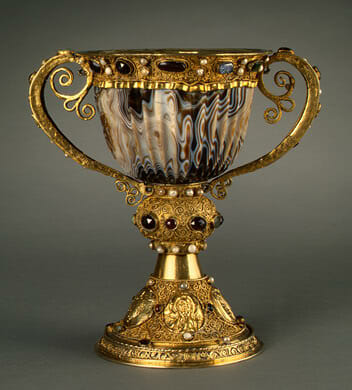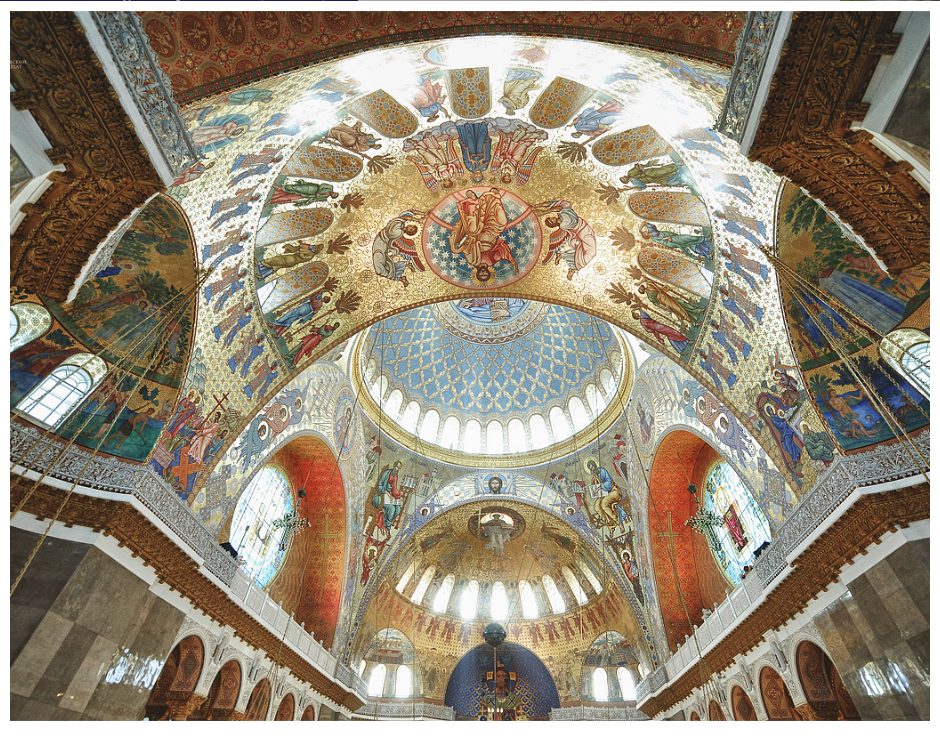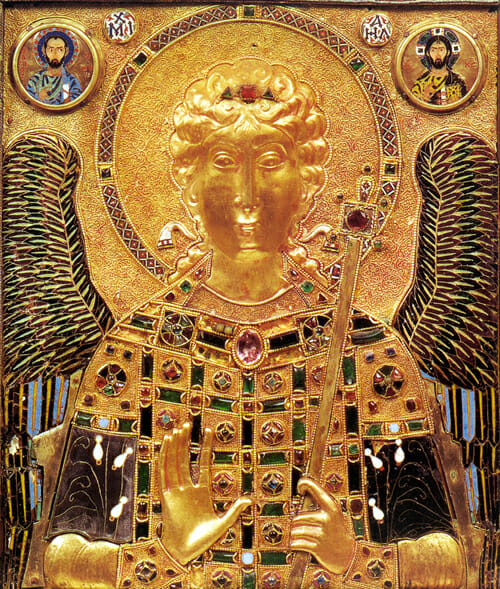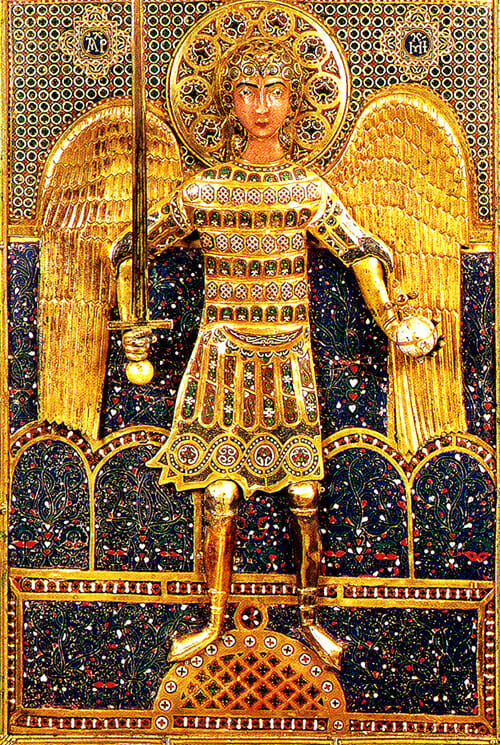Similar Posts
Uplifting Materiality and Symbol
We might grow dull in discriminating between the subtleties of the materials we use to create our living environments, but it is evident that they do affect our quality of life and state of mind. It goes without saying that living in a wooden cabin is not the same as living in a concrete apartment complex. We can speak of materials and objects, with their varied forms and textures, as “bodies” with which we interact. Bodies have a unique corresponding “glory.” As St. Paul says, “There are also celestial bodies and terrestrial bodies; but the glory of the celestial is one, and the glory of the terrestrial is another.”12 In other words, it can be said that every material’s manifest glory is an affecting energy that imprints on the soul through the senses. The heart, or nous (intellect), assimilates these impressions and is then shaped or colored by them in various ways. However, the person is not just a passive receptor, but, as an agent of sense perception or aesthetic experience, he will be shaped according to what he desires or wants. As St. Peter of Damascus says, “the human intellect is shaped by what it wants and is coloured by the forms of the things that it perceives.”13
Depending on how the person participates in, interacts with, or assimilates these affecting energies, he either can be aided and uplifted through them to contemplate spiritual realities or he can be dragged down, deluded by the euphoria of sensations. The “society of the spectacle” described above and the “bodies” of its environment have a corresponding “glory,” while the Church’s liturgical worship has another glory. Having a mind surrounded by appearances and wanting the artificial, we ourselves can become artificial if we are not watchful. We will be satisfied with facades, surrogates, and deceit.14 Conversely, the more we desire and love the Truth (i.e., Christ) and participate in the mysteries and Liturgy through their symbols, the more He is “shaped” or “formed” in us. Thus, being conformed to His likeness, we become icons of He Who is. As St. Paul says, “My little children, for whom I labor in birth again until Christ is formed in you … .”15
We can now extend these observations and talk about liturgical aesthetics. In liturgical worship, through participation in the “forms” of grace bearing matter, we ascend from the phenomenal to spiritual reality where we contemplate formless and uncreated Beauty. An example of this is found in the account of the conversion of the Slavs. Upon entering Hagia Sophia, the emissaries of St. Vladimir were struck by the splendor of its unearthly beauty, and could only say: “We did not know whether we were in heaven or on earth … .”16 The orchestrated glory of the materials they perceived led them to faith. They wanted the Truth and, finding the Unseen in the seen, they believed. The beauty they saw was a manifestation of the Truth and the Good, the splendor and glory of the Divine. Beauty became a vehicle of ascent towards God. Herein we find an abbreviated theology of the anagogic potential of materials in the liturgical context, their capability to spiritually uplift the soul and nous beyond the senses. As St. John of Damascus implies, the anagogic potential of materials and images “to reveal and make perceptible those things which are hidden,” is indispensable since our “soul is veiled by the body.”17 This is further described by St. Dionysius the Areopagite, who says “we lack the ability to be directly raised up to conceptual contemplation. We need our own uplifting that comes naturally to us and which can raise before us the permitted forms of the marvelous unformed sights … .”18 Therefore, “ecclesiastical traditions … explain spiritual truths with terms drawn from the sensual world, and super- essential truths in terms drawn from nature, clothing with shapes and forms the shapeless and formless, and by a variety of different symbols fashioning manifold attributes of immaterial and supernatural simplicity.”19 Of the hierarchs, he says that “using images derived from the senses they spoke of the transcendent … .”20
As noted above, this anagogic dynamic unfolds not only through images, but also through the unique qualities of the materials used to depict them and that make up the objects that we encounter in the various rites, blessings, and services of liturgical worship. These also speak a precise symbolic language that is not merely conventional in meaning, but providentially arranged. This meaning is based on the materials’ inner logoi (inner principles) that reside in Christ, the Logos.21 In other words, the spiritual content of the inherent properties or natures of the materials, which reflect Christ as their Source, for all creation declares the glory God. As St. Maximos says, “The mystery of the incarnation of the Logos is the key to all arcane symbolism … and … gives us knowledge of created things, both visible and invisible.”22 We can find passages in Scripture that point to the symbolism of materials, and these confirm how their properties are ultimately reflections of the Logos. For example, the capability of water to quench thirst is a reflection the Logos’ life sustaining power (“If anyone thirsts, let him come to Me and drink”).23 Or, in the change of a seed of wheat when it dies and bears harvest we find the mystery of the Passion and Resurrection (“The hour has come that the Son of Man should be glorified. Most assuredly, I say to you, unless a grain of wheat falls into the ground and dies, it remains alone; but if it dies, it produces much grain”).24 Or, in fire we find the Logo’s purifying and sanctifying power (“For our God is a consuming fire”).25 Therefore, symbolic substances such as water in Baptism, olive oil in the Chrism, and wine and bread in the Holy Eucharist are not arbitrarily chosen. They are not alterable, because they reveal and speak precisely of the mystery of which they are conveyers.
There are other substances and materials that play a symbolic role, such as pigments, wood, wax, wool, silk, incense, fire, silver, gold, precious stones, etc. These can be seen in the realm of visible creation as basic symbols. When through craftsmanship these are combined in the making of objects and images, such as icons, they can then be called compound symbols. Basic symbols can be seen as letters from the book of creation that are combined in various ways to form, through compound symbols, the grammar of an anagogic, liturgical language. In the realm of general culture, basic symbols, the elements, and materials of science and manufacture are also combined through various technologies to help order society, enhance the quality of life, or provide for basic necessities. Even here we find compound symbols, and these also have a grammar that will be either “opaque” or “translucent” in degrees, depending on how clearly they communicate (or reflect) the mystery of the Logos. Consequently, man can create monstrous combinations of basic symbols and thereby bemire, soil, and obscure the reflective potential of compound symbols. By obscuring their iconicity, man deprives them of anagogic efficacy. Man can either make nourishing food or poison, magnificent temples or bleak cities, distorted or lucid symbols. When man does not have eyes to see the glory of the Logos in all things, he begins to shape the world around him according to his blindness. He shapes it according to how things appear to be, not according to how they truly are. As St. Maximus says, “To those who have eyes to see, all the invisible (spiritual) world is mysteriously presented in symbols of the visible world; and all the natural world depends on the supernatural world.”26 As mentioned above, in compound symbols we find a grammar of an anagogic language. This is how, as St. Dionysius says, the tradition of the Church explains “spiritual truths with terms drawn from the sensual world.” Scripture conveys the symbolic importance of specific materials for uplifting the soul, as explained by St. Dionysius:
“The Word of God furthermore attributes to the heavenly beings the form of bronze, electrum, multicolored stones, and if it does so the reason lies in the fact that electrum, which contains gold and silver, symbolizes both the incorruptible, priceless, unfailing, and unpolluted radiance of gold as well as the gleam, the gloss, the splendor, and the heavenly glow of silver. As for bronze, it recalls either fire or gold, for the reasons given. With regard to the multicolored stones, these must be taken to work symbolically as follows: white for light, red for fire, yellow for gold, green for youthful vitality. Indeed you will find each form carries an uplifting explanation of the representational images.”27
The materials that St. Dionysius mentions here remain in the level of mental “representational images” that have a corresponding anagogic or “uplifting explanation.” The focus is on the interpretation of Scriptural passages. Nevertheless, these representations derive from sense perception. Therefore, the same principles of interpretation can be applied to materials physically seen or encountered in worship. Perhaps we can speak of two levels in anagogic ascent. The first pertains to the aesthetic experience. There is an immediate perceptual impact of the “glory” (energy) of “bodies” (materials or objects) on the person. The inherent properties of these materials and objects color or shape us. This can have such a powerful effect, as seen in the account of the conversion of the Slavs, that part of their inner meaning is grasped intuitively, moving or uplifting the person to a sense of awe, admiration, devotion, prayer, and faith. Second, these properties can then be “read” and their symbolic meaning or spiritual content contemplated, what St. Dionysius calls “conceptual contemplation” or “uplifting explanation.” The challenge is to learn how to “read,” not to solely gaze and stop on the “letter” of the aesthetic experience, but to move on to the “spirit” and arrive at a noetic apprehension of the inner meaning of basic or compound symbols. As St. Nikolai says, “Therefore, it may be said that nature worshipers are analphabetic, and spirit worshipers only are alphabetic. To the mind of the former, things and creatures in the natural world represent an ultimate reality, expressed in their forms, colors, functions and relations. While to the mind of the latter things and creatures are only the symbols of a spiritual reality which is the actual meaning and life and justification of those symbols.”28 St. Symeon the New Theologian clearly expresses the same idea and calls “bodies” symbols. He says, “The man who is enlightened by the Holy Spirit, the Revealer of all things, acquires new eyes and new ears, and sees no more as a natural man, namely by natural sight with natural sensation, but standing as it were beyond himself contemplates spiritually visible things and bodies as the symbols of the things invisible.”29
The “reading” of symbols, or seeing their inner meaning, does not come about without our striving, active pursuit or wanting to apprehend the Truth, as mentioned previously. But as St. Symeon points out, this unfolds in cooperation with the Holy Spirit and by acquiring virtue and purification of our heart, not just by arbitrary speculation. Though we may be apprehensive about this daunting task, it is possible to find patterns through diligent study of the Tradition as expressed in the Scriptures, the Fathers, the canon of iconography, and the inherent properties of materials, which serve as guides to an objective interpretation of the symbols. Symbols will always have a multiplicity of meaning. Although the interpretations might vary, they are not necessarily mutually exclusive since they all describe from different angles and levels the inexhaustible mystery of the Logos incarnate.30 An example that touches on the “reading” of material symbols is seen in the commentary of Abbot Suger regarding the treasures of the Abbey Church of St. Denis. Even though he does not elaborate in detail on his interpretation of jewels as virtues, we can nonetheless capture the orientation of his thought. In this text, he acknowledges the different levels of meaning to be read in the work of craftsmanship, expressing his conviction on the anagogic possibility of the property of materials. In describing the gemstones of the altar in the cathedral, which brought to mind the precious stones of Paradise,31 Abbot Suger says:
“To those who know the properties of precious stones, it becomes evident to their astonishment, that none is absent from the number of these … (except carbuncle) … the loveliness of the many coloured gems has called me away from external cares, and worthy meditation has induced me to reflect, transferring that which is material to that which is immaterial, on the diversity of the sacred virtues: then it seems to me that I see myself dwelling, as it were, in some strange region of the universe which neither exists entirely in the slime of earth nor entirely in the purity of Heaven; and that, by the grace of God, I can be transported from this inferior to that higher world in an anagogical manner.”32

The Chalice of Abbot Suger of Saint-Denis.
Translucent Sardonyx, symbol of the blood and water that flowed from the Lord’s side.
Notes:
12 1 Cor. 15:40.
13 St. Peter of Damaskos, The Philokalia Vol. Three, Faber and Faber, Inc., London and Boston, 1984, p.236.
14 Mc Luhan also says:“Media,by altering the environment,evoke in us unique ratios of sense perceptions. The extension of any one sense alters the way we think and act-the way we perceive the world. When these ratios change,men change.” M. Mc Luhan and Q. Fiore, The Medium is the Massage:An Inventory of Effects,Hardwire, San Francisco,1996, p.41.
15 Gal.4:19.
16 M. Quenot, The Icon: Window on the Kingdom, SVS Press, Crestwood, N.Y., 1991, p.46.
17 St. John of Damascus, On the Divine Images:Three Apologies Against Those Who Attack the DivineImages, SVS Press, N.Y., 1980,p.74.
18 As quoted by F. Ivanovic, Symbol and Icon:Dionysius the Areopagite and the Iconoclastic Crisis, Pickwick Pub., Eugene,Oregon,2010 pp.76-77.
19 As quoted by St. John of Damascus,On the DivineImages,op. cit., p.34.
20 Ivanovic, op. cit., p.59.
21 In the glossary of The Philokalia we read:“Logos:the Second Person of the Holy Trinity, or the Intellect, Wisdom and Providence of God in whom and through whom all things are created. As the unitary cosmic principle, the Logos contains in Himself the multiple logoi (inner principles or inner essences, thoughts of God) in accordance with which all things come into existence at the times and places, and in the forms, appointed for them, each single thing thereby containing in itself the principle of its own development…” ThePhilokaliaVol. Three, op. cit.,p.361.
22 St. Maximos the Confessor, The Philokalia Vol. Two, Faber and Faber, London and Boston, 1981, p.127. The full context of what St. Maximos says is: “The mystery of the incarnation of the Logosis the key to all the arcane symbolism and typology in the Scriptures,and in addition gives us knowledge of created things,both visible and intelligible. He who apprehends the mystery of the cross and the burial apprehends the inward essences of created things; while he who is initiated into the inexpressible power of the resurrection apprehends the purpose for which God first established everything.”Ibid.
23 John 7:37.
24 Ibid.,12:23–24.
25 Heb. 12:29.
26 St. Maximos the Confessor as quoted by St. Nikolai Velimerovich, The Universeas Symbols & Signs:An essay on Mysticism in the Eastern Church, St. Tikhon‘s Seminary Press, South Canaan/Waymart, Pennsylvania,2010, p.10.
27 Ivanovic, op. cit., p.59.
28 St. Nikolai Velimerovich,op. cit.,p.10.
29 St. Symeon the New Theologian, as quoted by St. Nikolai Velimerovich, Ibid.,p.10.
30 St. Peter of Damaskos says,“I am speaking about the person who possesses knowledge but distrusts himself until he finds another passage from Scripture or from one of the saints that confirms his spontaneous knowledge of the scriptural passage or of some sensible or intelligible reality.And if instead of one meaning he should find many as a result of giving attention to either the divine Scriptures or the holy fathers, he should not lose faith and think that there is a contradiction. For one text or object can signify many things. Take clothing,for example: one person may say that it warms, another that it adorns, and another that it protects; yet all three are correct, since clothing is useful alike for warmth, for adornment and for protection. All three have grasped the purpose assigned by God to clothing; and Holy Scripture and the very nature of things themselves confirm it … .” On the limits of knowledge he says,“For the saints neither know the whole of God‘s purpose with regard to every object or scriptural text, nor on the other hand do they write down once and for all everything that they do know. This is because in the first place God is beyond comprehension,and His wisdom is not limited in such away that an angel or man can grasp it in its entirety.” The Philokalia Vol. Three, op. cit., pp.264-65.
31 Ezekiel. 28:13.
32 S. Bucklow, The Alchemy of Paint:Art, Science and Secrets from the Middle Ages, Marion Boyars,London2009, pp.211–12.




This article is progressing wonderfully. I have always been tempted to use McLuhan as a kind witness to traditional art. He was, few people seem to remember, a convert to Catholicism critiquing modernity, rather than only the “Wired” hipster version we get of him in post-modern logorrhea on media. Unlike Benjamin who’s thesis on the mechanical was framed in revolutionary terms, McLuhan was appalled… another interesting traditional meets post-modern thinker to consider is Paul Virilio, collaborator of Baudrillard who converted to Catholicism as well. His work on speed, scale and the modern state as being fueled by war is quite surprising when you consider his public.
The theorists of the post-modern and media culture might not have all the answers right, but the symptoms they describe are dead-on at times. I find it quite amusing and ironic that those who might not be coming from a traditional worldview, and even revolt against it, nevertheless, in describing the contemporary malaise, unconsciously betray a nostalgia for a social environment that is more spiritually healthy, humane- theocentric. I will have to look at the work of Paul Virilio. Thanks.